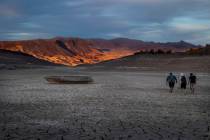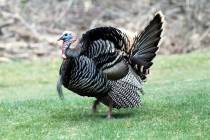Access, availability of public lands key to hunting’s future
For the past two decades, participation in hunting has steadily declined. For most of us, this is no secret. The subject has been discussed in a variety of outdoor publications, and I have touched upon it in a past column or two. The question is: Why are we losing hunters?
Answers to that question vary, but the top two answers from a recent study are centered on public access and crowding issues. The study was conducted by Responsive Management, a public opinion and attitude survey research firm specializing in natural resource and outdoor recreation issues. According to that study, 46 percent of hunters believe there is not enough public access to places where they can hunt, and 44 percent said there are not enough places to hunt. Where there is a place for hunters to pursue their quarry, 35 percent of survey respondents thought overcrowding was an issue.
As a general rule, these issues aren't as much of a problem in Nevada as they are in other states, although there are some exceptions. In the Ruby Mountains of Elko County, for example, there is plenty of public land, but gaining access to most of it is difficult at best, because the range is nearly surrounded with private land at its base, and public access points are few. As the state continues to grow, however, this situation undoubtedly will be replicated in other areas.
In August 2007, President Bush signed an executive order that many hoped would help to alleviate access and overcrowding issues for America's hunters, especially on public lands. Executive Order No. 13443: Facilitation of Hunting Heritage and Wildlife Conservation directs federal agencies and departments "to facilitate the expansion and enhancement of hunting opportunities and the management of game species and their habitat."
The order also charges the departments of Interior and Agriculture -- the two largest federal land-management departments -- with evaluating the effects of their management and other actions on hunting participation. They also were directed to consider the economic and recreational values of hunting, to manage wildlife and wildlife habitats to expand and enhance hunting opportunities, and to work collaboratively with state and tribal wildlife managers.
As part of that executive order, Bush included a call for the chairman of the Council on Environmental Quality to convene a White House conference on North American wildlife policy, at which an exchange of information and ideas could take place between leaders and professionals in the wildlife conservation arena. It is hoped this exchange will facilitate the development of a 10-year recreational hunting and wildlife conservation plan that will lay the groundwork for fulfilling the actions called for in the executive order.
Nevada will serve as host for that conference Oct. 1-3 in Reno, with the meeting modeled somewhat after the first such conference held in 1908 under the direction of President Theodore Roosevelt. That conference was a meeting of the country's governors, and conservation of our natural resources was the subject matter. Roosevelt, of course, is noted for his hunting exploits and for leading the way on setting aside the public lands so many of us have grown up exploring here in the West.
After that conference, the attending governors issued a declaration, part of which read: "We the Governors of the States and Territories of the United States of America, in Conference assembled, do hereby declare the conviction that the great prosperity of our country rests upon the abundant resources of the land chosen by our forefathers for their homes and where they laid the foundation of this great Nation.
"We look upon these resources as a heritage to be made use of in establishing and promoting the comfort, prosperity and happiness of the American People, but not to be wasted, deteriorated or needlessly destroyed."
On the 2008 conference agenda are eight core issues: maintaining access to public and private land; funding for wildlife conservation; management of wildlife habitat; education, recruitment and retention of hunters; the North American Model of Wildlife Conservation; federal, state and tribal coordination; climate change impacts; and energy development. Rumor has it that President Bush might be one of the speakers.
More information about the conference, as well as conference registration, can be accessed via the Internet (wildlifeconservation.gov).
• YOUTH TRAPPING DAY -- The Nevada Trappers Association will host a youth trapping day from 8 a.m. to noon Saturday at Mack's Canyon in the Spring Mountain Range. The event will include miniseminars, demonstrations and hands-on activities. Lunch and soft drinks will be provided.
Take U.S. Highway 95 north to the Lee Canyon turnoff (State Highway 158), go west 13 miles and turn right at the sign.
Doug Nielsen is an award-winning freelance writer and a conservation educator for the Nevada Department of Wildlife. His "In the Outdoors" column is published Thursday. He can be reached at doug@takinitoutside.com.

















